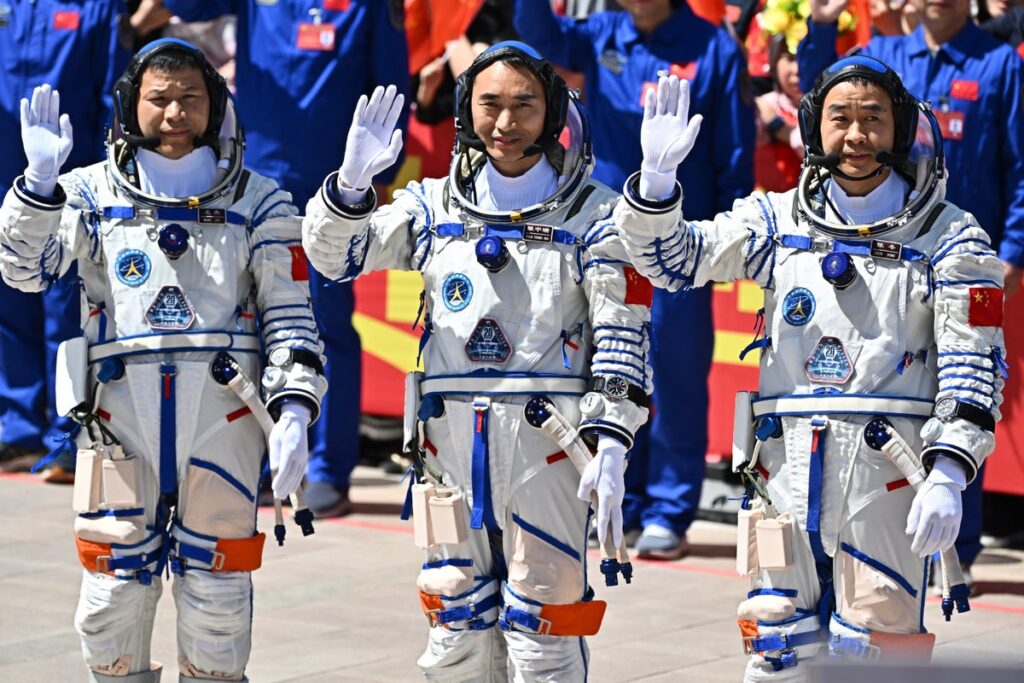November 14, 2025
1 min read
Stranded Chinese Astronauts Return to Earth, but Space Junk Threats Remain
The Shenzhou 20 spacecraft was too damaged to bring its crew home from China’s Tiangong space station. Those astronauts have now returned via the Shenzhou 21 craft, leaving its crew without a return ride until the nation sends a new spacecraft to the station
Astronauts for China’s Shenzhou-20 space mission Wang Jie, Chen Zhongrui and Chen Dong wave before boarding a bus to take them to the Shenzhou-20 spaceship on April 24, 2025.
Pedro Pardo/AFP via Getty Images
Three Chinese astronauts who had been stranded for days in space after a suspected piece of space junk hit their spacecraft are back on Earth, the China Manned Space Engineering Office (CMSE) announced on Friday.
The agency also revealed that it had found tiny cracks in one of the windows of the crew’s Shenzou 20 return capsule—rendering it unusable.
The astronauts instead returned onboard the Shenzhou 21 spacecraft, which had originally been used by Shenzou 20’s replacement crew. China had planned to keep the Shenzhou 21 capsule docked at its Tiangong space station to return those astronauts at the end of their mission, which is currently slated for April 2026.
On supporting science journalism
If you’re enjoying this article, consider supporting our award-winning journalism by subscribing. By purchasing a subscription you are helping to ensure the future of impactful stories about the discoveries and ideas shaping our world today.
“I’m very glad that they got home, but it is a bit disconcerting that the replacement crew apparently does not have a vehicle to come back to Earth,” says Victoria Samson, chief director of space security and stability at the Colorado-based nonprofit Secure World Foundation.
CMSE told the Chinese news agency Xinhua that a new spacecraft, Shenzhou 22, will be launched at an “appropriate time in the future,” meaning that Tiangong’s remaining three-person crew currently has no means of returning to Earth in the event of an emergency.
It’s unclear what kind of debris struck Shenzhou 20, but Samson speculated that it was likely tiny—perhaps between one and 10 centimeters in diameter—which is too small for astronomers to track.
“This again underlines the argument for not deliberately creating debris in orbit,” Samson said.
It’s Time to Stand Up for Science
If you enjoyed this article, I’d like to ask for your support. Scientific American has served as an advocate for science and industry for 180 years, and right now may be the most critical moment in that two-century history.
I’ve been a Scientific American subscriber since I was 12 years old, and it helped shape the way I look at the world. SciAm always educates and delights me, and inspires a sense of awe for our vast, beautiful universe. I hope it does that for you, too.
If you subscribe to Scientific American, you help ensure that our coverage is centered on meaningful research and discovery; that we have the resources to report on the decisions that threaten labs across the U.S.; and that we support both budding and working scientists at a time when the value of science itself too often goes unrecognized.
In return, you get essential news, captivating podcasts, brilliant infographics, can’t-miss newsletters, must-watch videos, challenging games, and the science world’s best writing and reporting. You can even gift someone a subscription.
There has never been a more important time for us to stand up and show why science matters. I hope you’ll support us in that mission.

